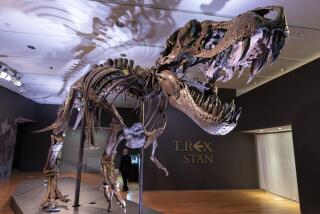Fossils indicate cousin of T. rex had a shaggy coat
When it comes to dino outerwear, shag might be the new scales.
Fossil evidence from a trio of 125-million-year-old dinosaurs that were relatives of Tyrannosaurus rex indicates the giant creatures wore primitive feathers.
The three tyrannosauroids -- one adult and two juveniles -- belong to a newly described species discovered in northeastern China. The full-grown Yutyrannus huali weighed 3,000 pounds and stretched about 30 feet from nose to tail. The younger ones were still impressive at about 1,100 and 1,300 pounds. The fossils are described in a study published in Thursdayâs edition of the journal Nature.
The dinosaurs are noteworthy for being such complete specimens, scientists said. But the most eye-catching part of the find might well be the patchily preserved signs of fossilized feathers around different parts of the animalsâ bodies. Indeed, the âYuâ in the creaturesâ name is the Mandarin word for feather, and âhualiâ means beautiful, a reference, the study authors said, to the animalsâ plumage.
The feathers varied in length. Some on the tail were about 6 inches long; others, hanging from the neck, measured about 8 inches.
Given that the three dinosaurs had feathery patches in different locations -- adorning, among their collected parts, the hips, foot and forelimbs -- and given that feathers are known to be preserved in bits and pieces even in birds with full plumage, itâs likely that Y. huali wore a full feather coat too, said Corwin Sullivan, a vertebrate paleontologist who worked on the study.
âIt was quite clear we had something impressive,â said Sullivan, who is based at the Institute of Vertebrate Paleontology and Paleoanthropology in the Chinese Academy of Sciences in Beijing.
The ancient feathers are not like those seen today. These plumes werenât used for flight; they were filamentary and lacked a complex structure, giving the dinosaurs who wore them more of a fuzzy appearance.
âI think this animal would have looked quite shaggy in life,â Sullivan said.
The presence of feathers isnât entirely surprising. After all, these dinosaurs hail from a group known as theropods, which include both T.rex and the ancestors of modern birds.
But the findings overturn the long-held assumption that feathers were primarily a feature of smaller dinosaurs rather than larger ones, experts said.
Most theories about feather evolution presume that they arose for some purpose other than flight. A leading idea is that they provided insulation for the cold-blooded creatures, much the way hair and fur keep mammals warm.
If so, this would have been especially useful for smaller animals, whose bodies have comparatively more surface area in relation to their overall volume, causing them to lose heat more easily. The extra protection from the elements would have come in handy.
But this isnât a big problem for larger animals. With comparatively less surface area in relation to the size of their bodies, they are able to retain heat much more effectively.
Fur or hair thus becomes less necessary, and perhaps, in warmer climes, even a little uncomfortable. Itâs not a hard-and-fast rule, but it is a strong tendency, one that should hold for feathers as well.
Sullivan pointed out that in this particular region of present-day China, near North Korea, the climate would have been relatively cooler than in surrounding areas.
The average temperature where Y. huali roamed was about 50 degrees, compared with 64 degrees elsewhere, so a downy coat could have come in handy.
âItâs pretty exciting,â said Thomas Holtz, a dinosaur paleontologist at the University of Maryland who was not involved in the study. âFinding a complete articulated skeleton of a large dinosaur is fairly rare, and here there are three almost complete skeletons found. Thatâs pretty amazing.â
The findings open up the possibility that other large dinosaurs -- perhaps even the fearsome T.rex, about six times as massive as Y.huali -- might have been feathered as well. âItâs definitely something thatâs in consideration now,â Holtz said.
The researchers, led by Sullivanâs colleague at the institute, Xing Xu, examined the fossils with extra rigor to confirm their authenticity because they were discovered not by scientists but by independent collectors who sold them to Chinese museums.
That practice often creates issues for scientists, who usually glean crucial information about these long-dead creatures from the land in which they were found. In this case, the researchers donât know exactly where the Y. huali skeletons were unearthed.
âWhen these commercial collectors go after the stuff like trophies,â Holtz said, âtheyâre missing all that other context that can help us answer so much else about the world of dinosaurs.â
--






